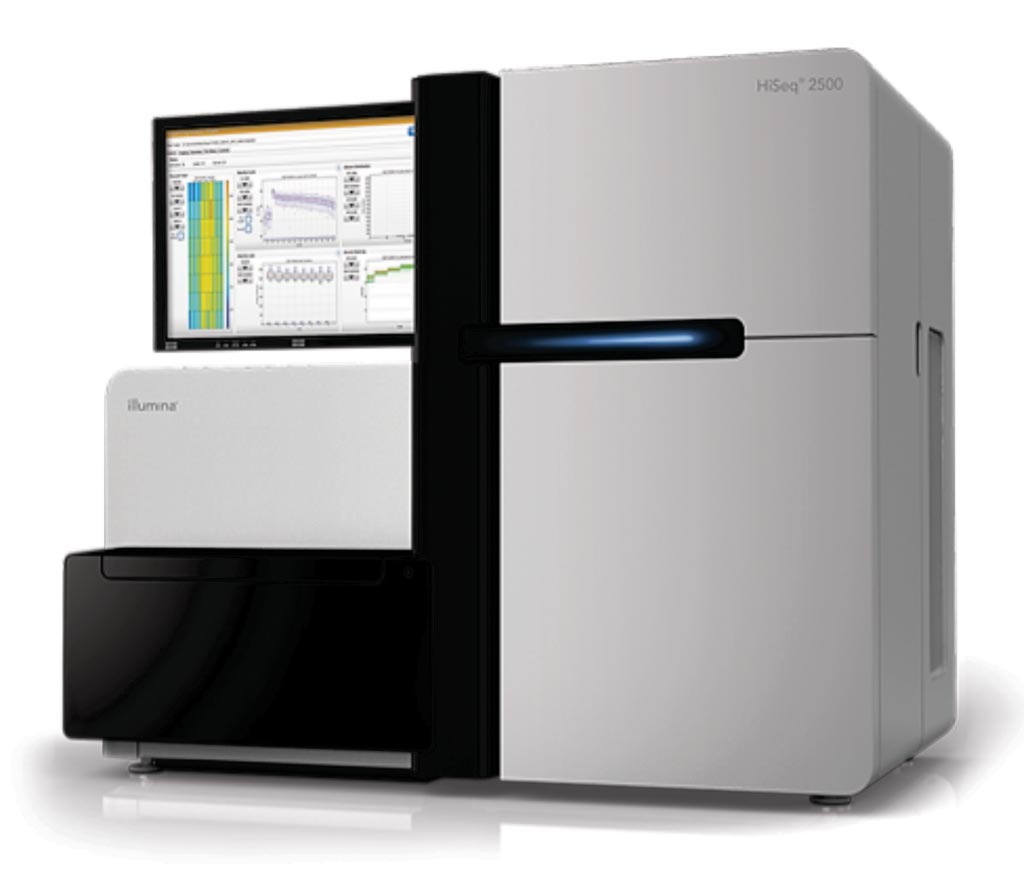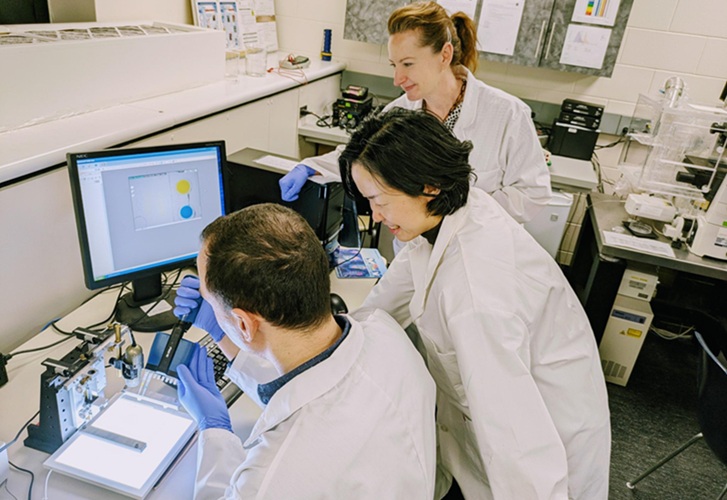Preterm Birth Clues Identified in Cervicovaginal Microbiome
|
By LabMedica International staff writers Posted on 03 Apr 2019 |

Image: The HiSeq 2500 System is a powerful high-throughput sequencing system (Photo courtesy of Illumina).
Failure to predict and understand the causes of preterm birth, the leading cause of neonatal morbidity and mortality, have limited effective interventions and therapeutics. Preterm birth (PTB) is defined as birth before 37 completed weeks of gestation and is the leading cause of death in neonates and children under the age of 5.
The interaction between microbial communities and their host, in many biological niches, has been found to be mechanistically involved in health and disease pathogenesis. There have been only a few studies that have examined the relationship between cervicovaginal microbial communities and spontaneous preterm birth.
A group of scientists collaborating with the University of Maryland School of Medicine (Baltimore, MD, USA) enrolled within 2,000 pregnant women, and identified a few hundred women for a nested case-control study of spontaneous preterm birth (sPTB), a group that included 107 extensively phenotyped women who gave birth prior to 37 weeks of gestation and 432 unaffected women who delivered their babies at term. Nearly three-quarters of the participants were African-American, and the median age of the mothers was 28 years old. The investigators had access to cervicovaginal swab samples and anthropometric measurements collected at three points during pregnancy: at 16 to 20 weeks gestation, 20 to 24 weeks gestation, and between 24 and 28 weeks gestation.
Amplicons were visualized on a 2% agarose gel, quantified, pooled in equimolar concentration, and purified prior to loading on an Illumina HiSeq 2500 modified to generate 300 bp paired-end reads. When the scientists compared microbial community members in cervicovaginal samples from those cases and controls, which were profiled with 16S ribosomal RNA gene sequencing, they saw seven bacterial taxa that appeared to be associated with spontaneous preterm birth, particularly in women with African-American ancestry. The team studied that association further using enzyme-linked immunosorbent assay (ELISA)-based immunological profiling, focused on host-derived anti-microbial peptides known as beta-defensin-2, that have previously been described in studies of the genital tract, both in healthy women and those suffering from bacterial infections.
The results indicated that the presence of Lactobacillus bacteria that are normally considered beneficial did not necessary coincide with diminished risk of spontaneous preterm birth. Instead, the data suggested that enhanced beta-defensin-2 levels in cervicovaginal samples typically coincided with decreased spontaneous preterm birth risk, while lower-than-usual levels of the protein tended to track with increased risk, even when high levels of bacteria belonging to Lactobacillus species were present. That beta-defensin-2 effect was especially pronounced in the African-American women, but was not significant when the team analyzed data for non-African-American women alone. Likewise, African-American women who delivered their infants at term also had increased beta-defensin-2 levels compared to non-African-American women with at-term deliveries.
The author concluded that higher vaginal levels of β-defensin-2 lowered the risk sPTB associated with cervicovaginal microbiota in an ethnicity-dependent manner. Surprisingly, even in Lactobacillus spp. dominated cervicovaginal microbiota, low β-defensin-2 was associated with increased risk of sPTB. Their findings hold promise for diagnostics to accurately identify women at risk for sPTB early in pregnancy. The study was published on March 21, 2019, in the journal Nature Communications.
Related Links:
University of Maryland School of Medicine
The interaction between microbial communities and their host, in many biological niches, has been found to be mechanistically involved in health and disease pathogenesis. There have been only a few studies that have examined the relationship between cervicovaginal microbial communities and spontaneous preterm birth.
A group of scientists collaborating with the University of Maryland School of Medicine (Baltimore, MD, USA) enrolled within 2,000 pregnant women, and identified a few hundred women for a nested case-control study of spontaneous preterm birth (sPTB), a group that included 107 extensively phenotyped women who gave birth prior to 37 weeks of gestation and 432 unaffected women who delivered their babies at term. Nearly three-quarters of the participants were African-American, and the median age of the mothers was 28 years old. The investigators had access to cervicovaginal swab samples and anthropometric measurements collected at three points during pregnancy: at 16 to 20 weeks gestation, 20 to 24 weeks gestation, and between 24 and 28 weeks gestation.
Amplicons were visualized on a 2% agarose gel, quantified, pooled in equimolar concentration, and purified prior to loading on an Illumina HiSeq 2500 modified to generate 300 bp paired-end reads. When the scientists compared microbial community members in cervicovaginal samples from those cases and controls, which were profiled with 16S ribosomal RNA gene sequencing, they saw seven bacterial taxa that appeared to be associated with spontaneous preterm birth, particularly in women with African-American ancestry. The team studied that association further using enzyme-linked immunosorbent assay (ELISA)-based immunological profiling, focused on host-derived anti-microbial peptides known as beta-defensin-2, that have previously been described in studies of the genital tract, both in healthy women and those suffering from bacterial infections.
The results indicated that the presence of Lactobacillus bacteria that are normally considered beneficial did not necessary coincide with diminished risk of spontaneous preterm birth. Instead, the data suggested that enhanced beta-defensin-2 levels in cervicovaginal samples typically coincided with decreased spontaneous preterm birth risk, while lower-than-usual levels of the protein tended to track with increased risk, even when high levels of bacteria belonging to Lactobacillus species were present. That beta-defensin-2 effect was especially pronounced in the African-American women, but was not significant when the team analyzed data for non-African-American women alone. Likewise, African-American women who delivered their infants at term also had increased beta-defensin-2 levels compared to non-African-American women with at-term deliveries.
The author concluded that higher vaginal levels of β-defensin-2 lowered the risk sPTB associated with cervicovaginal microbiota in an ethnicity-dependent manner. Surprisingly, even in Lactobacillus spp. dominated cervicovaginal microbiota, low β-defensin-2 was associated with increased risk of sPTB. Their findings hold promise for diagnostics to accurately identify women at risk for sPTB early in pregnancy. The study was published on March 21, 2019, in the journal Nature Communications.
Related Links:
University of Maryland School of Medicine
Latest Molecular Diagnostics News
- Blood Test Could Identify Patients at Risk for Severe Scleroderma
- Gene-Based Blood Test Accurately Predicts Tumor Recurrence of Advanced Skin Cancer
- Rapid Blood Test Identifies Pre-Symptomatic Patients with Parkinson’s Disease
- Blood Test for Early Alzheimer's Detection Achieves Over 90% Accuracy
- RNA-Based Blood Test Detects Preeclampsia Risk Months Before Symptoms
- First Of Its Kind Test Uses microRNAs to Predict Toxicity from Cancer Therapy
- Novel Cell-Based Assay Provides Sensitive and Specific Autoantibody Detection in Demyelination
- Novel Point-of-Care Technology Delivers Accurate HIV Results in Minutes
- Blood Test Rules Out Future Dementia Risk
- D-Dimer Testing Can Identify Patients at Higher Risk of Pulmonary Embolism
- New Biomarkers to Improve Early Detection and Monitoring of Kidney Injury
- Chemiluminescence Immunoassays Support Diagnosis of Alzheimer’s Disease
- Blood Test Identifies Multiple Biomarkers for Rapid Diagnosis of Spinal Cord Injury
- Highly Accurate Blood Test Diagnoses Alzheimer’s and Measures Dementia Progression
- Simple DNA PCR-Based Lab Test to Enable Personalized Treatment of Bacterial Vaginosis
- Rapid Diagnostic Test to Halt Mother-To-Child Hepatitis B Transmission
Channels
Clinical Chemistry
view channel
Low-Cost Portable Screening Test to Transform Kidney Disease Detection
Millions of individuals suffer from kidney disease, which often remains undiagnosed until it has reached a critical stage. This silent epidemic not only diminishes the quality of life for those affected... Read more
New Method Uses Pulsed Infrared Light to Find Cancer's 'Fingerprints' In Blood Plasma
Cancer diagnoses have traditionally relied on invasive or time-consuming procedures like tissue biopsies. Now, new research published in ACS Central Science introduces a method that utilizes pulsed infrared... Read moreHematology
view channel
New Scoring System Predicts Risk of Developing Cancer from Common Blood Disorder
Clonal cytopenia of undetermined significance (CCUS) is a blood disorder commonly found in older adults, characterized by mutations in blood cells and a low blood count, but without any obvious cause or... Read more
Non-Invasive Prenatal Test for Fetal RhD Status Demonstrates 100% Accuracy
In the United States, approximately 15% of pregnant individuals are RhD-negative. However, in about 40% of these cases, the fetus is also RhD-negative, making the administration of RhoGAM unnecessary.... Read moreImmunology
view channel
Stem Cell Test Predicts Treatment Outcome for Patients with Platinum-Resistant Ovarian Cancer
Epithelial ovarian cancer frequently responds to chemotherapy initially, but eventually, the tumor develops resistance to the therapy, leading to regrowth. This resistance is partially due to the activation... Read more
Machine Learning-Enabled Blood Test Predicts Immunotherapy Response in Lymphoma Patients
Chimeric antigen receptor (CAR) T-cell therapy has emerged as one of the most promising recent developments in the treatment of blood cancers. However, over half of non-Hodgkin lymphoma (NHL) patients... Read moreMicrobiology
view channel
Handheld Device Delivers Low-Cost TB Results in Less Than One Hour
Tuberculosis (TB) remains the deadliest infectious disease globally, affecting an estimated 10 million people annually. In 2021, about 4.2 million TB cases went undiagnosed or unreported, mainly due to... Read more
New AI-Based Method Improves Diagnosis of Drug-Resistant Infections
Drug-resistant infections, particularly those caused by deadly bacteria like tuberculosis and staphylococcus, are rapidly emerging as a global health emergency. These infections are more difficult to treat,... Read more
Breakthrough Diagnostic Technology Identifies Bacterial Infections with Almost 100% Accuracy within Three Hours
Rapid and precise identification of pathogenic microbes in patient samples is essential for the effective treatment of acute infectious diseases, such as sepsis. The fluorescence in situ hybridization... Read morePathology
view channel
Novel UV and Machine Learning-Aided Method Detects Microbial Contamination in Cell Cultures
Cell therapy holds great potential in treating diseases such as cancers, inflammatory conditions, and chronic degenerative disorders by manipulating or replacing cells to restore function or combat disease.... Read more
New Error-Corrected Method to Help Detect Cancer from Blood Samples Alone
"Liquid biopsy" technology, which relies on blood tests for early cancer detection and monitoring cancer burden in patients, has the potential to transform cancer care. However, detecting the mutational... Read more
"Metal Detector" Algorithm Hunts Down Vulnerable Tumors
Scientists have developed an algorithm capable of functioning as a "metal detector" to identify vulnerable tumors, marking a significant advancement in personalized cancer treatment. This breakthrough... Read more
Novel Technique Uses ‘Sugar’ Signatures to Identify and Classify Pancreatic Cancer Cell Subtypes
Pancreatic cancer is often asymptomatic in its early stages, making it difficult to detect until it has progressed. Consequently, only 15% of pancreatic cancers are diagnosed early enough to allow for... Read moreTechnology
view channel
Pain-On-A-Chip Microfluidic Device Determines Types of Chronic Pain from Blood Samples
Chronic pain is a widespread condition that remains difficult to manage, and existing clinical methods for its treatment rely largely on self-reporting, which can be subjective and especially problematic... Read more
Innovative, Label-Free Ratiometric Fluorosensor Enables More Sensitive Viral RNA Detection
Viruses present a major global health risk, as demonstrated by recent pandemics, making early detection and identification essential for preventing new outbreaks. While traditional detection methods are... Read moreIndustry
view channel
Cepheid and Oxford Nanopore Technologies Partner on Advancing Automated Sequencing-Based Solutions
Cepheid (Sunnyvale, CA, USA), a leading molecular diagnostics company, and Oxford Nanopore Technologies (Oxford, UK), the company behind a new generation of sequencing-based molecular analysis technologies,... Read more
Grifols and Tecan’s IBL Collaborate on Advanced Biomarker Panels
Grifols (Barcelona, Spain), one of the world’s leading producers of plasma-derived medicines and innovative diagnostic solutions, is expanding its offer in clinical diagnostics through a strategic partnership... Read more





















